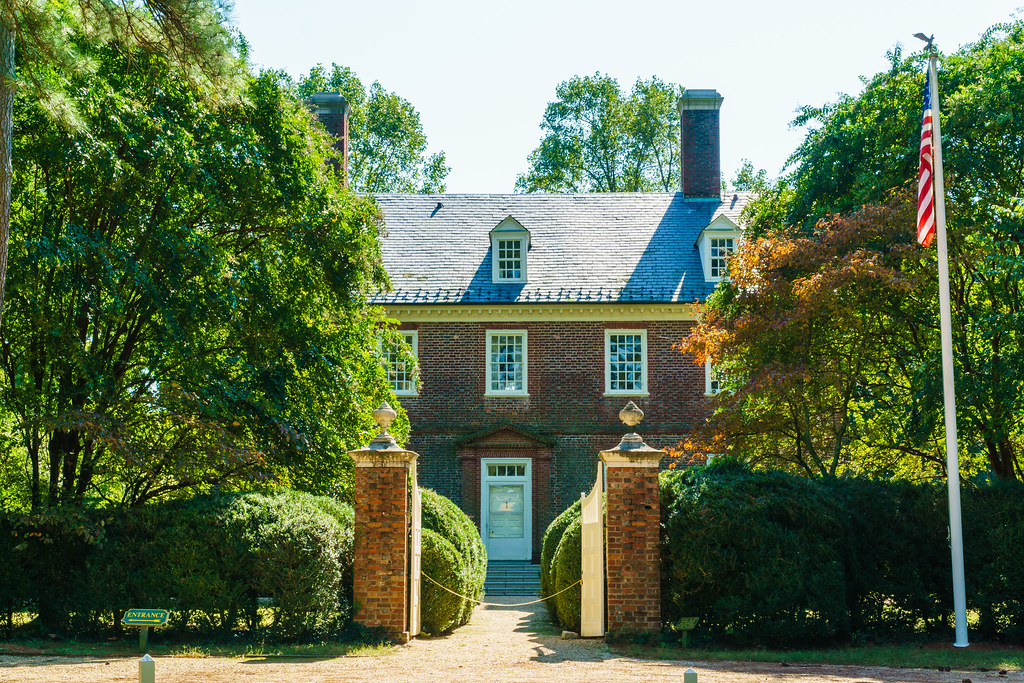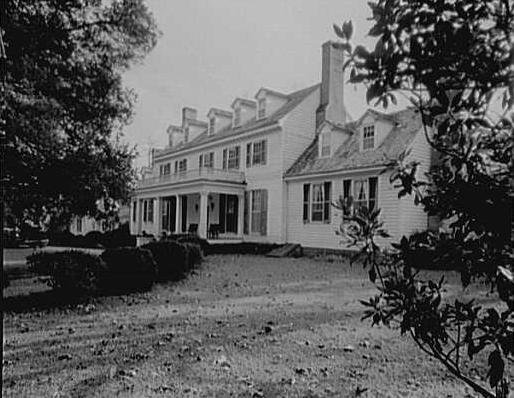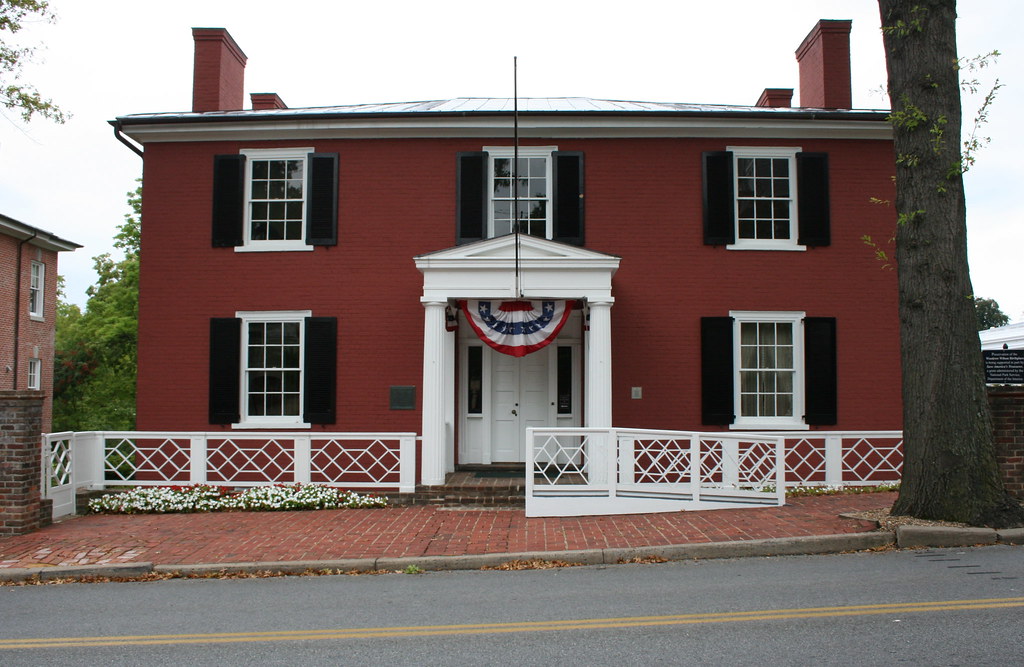
The state of Virginia has deep ties with American history, especially as the place where the founding fathers created our nation. Most colonists to the “New World” arrived in coastal Virginia. History buffs can find countless presidential landmarks across the great state. We’ve left out the monuments and landmarks in Washington DC, but there is plenty of history there as well!
This post contains affiliate links.
George Washington, #1
Our nation’s first president was born in Bridges Creek to a family of wealthy tobacco planters. He later rose to notoriety as the leader of the Continental Army during the Revolutionary War.
He presided over the Constitutional Convention that led to the creation of the country’s guiding document. While he never sought to be president, his military background made him an ideal leader. Washington was never a part of any political party and established many of the traditions that carry over today.
George Washington Birthplace National Monument, Colonial Beach

See where our founding father spent his formative years at George Washington Birthplace National Monument, which has been recreated to how it would have looked during that time. Heritage breed animals roam the property, including descendants of the Red Devon Oxen that Washington’s family owned.
George Washington’s Mount Vernon, Mount Vernon

Visitors can tour the 18th-century mansion at George Washington’s Mount Vernon where the president and first lady lived out their days. Originally built in 1735 by his father, his brother named the now-famous estate before George took over in 1754.
He added to the home’s size, which is open for tours. The attraction also includes gardens, the tombs of George and Martha, a blacksmith shop, and a museum of artifacts like the famous dentures.
Book your spot on a Mount Vernon and Old Town Alexandria Day Trip from Washington DC.
Thomas Jefferson, #3
Another one of the Founding Fathers is Thomas Jefferson, who was born in colonial Virginia and later attended the praised College of William and Mary. During the American Revolution, he was a part of the Continental Congress.
He served as Secretary of State under George Washington and vice president under John Adams. His legacy is known for his work in architecture as well as political philosophies on religious freedom but is sometimes overshadowed by his personal life. History suggests that he fathered children with his slave Sally Hemings.
Monticello, Charlottesville

Once his days in leadership were over, he retired to a quiet life in the countryside at his home, Monticello. Many of his books were donated to the Library of Congress and he established the nearby University of Virginia.
He designed his home and its unique details and frequently hosted visitors. Now one of the country’s best museums, the home’s rooms are open for tours and the grounds interpret the time period. He is buried on the grounds. And if this stunning home wasn’t enough, he also had Poplar Forest, a second getaway near Lynchburg.
Book your spot on the Monticello and Wine Tour with Crozet Trolley.
University of Virginia, Charlottesville

Based on the prestigious universities in England, the University of Virginia in Charlottesville was the brainchild of Jefferson with its signature rotunda. It was established in 1819 and is one of the nation’s finest. Fans of Jefferson can also see where he studied and lived at the William & Mary and the Governor’s Palace, both in Williamsburg.
Virginia State Capitol, Richmond

The Virginia State Capitol is the nation’s oldest legislative body and the current building was designed by Thomas Jefferson and Charles-Louis Clerisseau, inspired by Maison Carree in France. Completed in 1788, it contains many of his signature features, including a rotunda. A statue of Jefferson sits on the grounds. It’s open to guided and self-guided tours.
James Madison, #4
Born near Port Conway, Madison grew up in a large family on a plantation called Mount Pleasant before moving to Montpelier. He joined a local militia during the Revolutionary War and rose through the ranks as a leader.
Later, he served as an advisor to Washington and became a member of the House of Representatives. He is best remembered for his writings, especially his role in the Constitution, the Bill of Rights, and the Federalist Papers. Along with Jefferson, he established the political parties that still exist today. Madison was also a staunch supporter of freedom of religion.
Belle Grove Plantation, Port Conway
Madison was raised at Belle Grove Plantation, which was built in 1791 on the Rappahannock River. Located 30 minutes outside of Fredericksburg, today it serves as a bed and breakfast and wedding venue. Guest rooms are named after notable residents and contain period antiques.
Montpelier, Orange

See where James and Dolley spent their days at the Montpelier’s Visitor Center. The land belonged to Madison’s grandfather and the family relocated here in 1732. Once James married Dolley, they expanded the original structure to add more space.
After Madison’s death, the DuPont family purchased it, so the home features rooms from both periods as well as museum artifacts related to both families. A permanent exhibit educates visitors about slavery at Montpelier and throughout the region.
James Monroe, #5
Born in rural Westmoreland County, James Monroe was of Scottish and French Huguenot heritage. He fought in the Revolutionary War and was later wounded before serving as a delegate to the Continental Congress.
Monroe became a senator in the very first United States Congress and served as governor of Virginia, secretary of state, secretary of war, and diplomat to France before becoming president. He is best remembered for his role in securing the Louisiana Purchase, the establishment of the nation of Liberia for freed slaves, and the Monroe Doctrine.
Ash Lawn-Highland, Charlottesville

Monroe met his wife in New York and they later relocated to Ash Lawn-Highland near Charlottesville in 1799. It was just one of many properties he would own, but he struggled with his finances. The Monroes were one of many families to live on the property and the visitor’s center and tour interpret the timelines and structures.
There’s little more than a historic marker at the James Monroe Birthplace in Colonial Beach but is worth a visit if you’re nearby. The James Monroe Museum and Memorial Library in Fredericksburg is believed to be on the site of Monroe’s former law offices.
It now houses a collection of items related to the family and the building’s history. Monroe also had a farm near the University of Virginia campus as well as Oak Hill, which is now a private home. He was re-interred after his death at Hollywood Cemetery in Richmond, where John Tyler and Jefferson Davis are also buried.
Visit Monroe’s grave, alongside other presidents, on the Hollywood Cemetery Electric Car Tour in Richmond.
William Henry Harrison, #8
William Henry Harrison was born in Charles City County in 1773 at Berkeley Plantation. His father was a signer of the Declaration of Independence, served as governor of Virginia, and fought in the Revolutionary War, so perhaps civil duty was instilled in young William.
After his education was completed at Hampden-Sydney College, he fought in the Northwest Indian War. He was married at age 22 and went on to become the first congressional delegate from the Northwest Territory and Indiana territorial governor.
He spent much of his life in Ohio and Indiana before becoming president. Sadly, he had the shortest term after falling ill and dying less than a month after taking office.
Berkeley Plantation, Charles City

Berkeley Plantation sits on the James River and is the oldest three-story brick mansion in the state. Both William and great-great-grandson Benjamin Harrison lived here before becoming president. It was also the site of the first Thanksgiving festivities. Guides in period costumes offer tours of the mansion. They also have seasonal events.
Visit the home of Harrison on the Electric Bike Tour to Historical Berkeley Plantation with Lunch.
John Tyler, #10
Also born in Charles City, Virginia, his family had ties to Thomas Jefferson and Benjamin Harrison V. Like his counterparts, he also studied at the College of William and Mary. Tyler served as a Virginia state legislator, governor, US Representative, and US senator before running as vice president of William Henry Harrison.
He took over his position after his death and is known for treaties with China and England. After his term in office and failing to gain support for another term, he became a member of the Confederate House of Representatives during the Civil War.
Sherwood Forest Plantation, Charles City

Tyler owned a number of homes during his life. Greenway Plantation is currently under private ownership, but he lived here from his birth until age 39. During this time, he sold it and moved to Sherwood Forest Plantation Foundation, formerly owned by Harrison.
It was here that he remained for his last twenty years. Now open for self-guided tours of the grounds and guided tours by appointment, it is still owned by the Tyler family. There was also a period in his twenties when he lived at Woodburn, a Palladian mansion that is now a private residence. A historic marker designates it.
Zachary Taylor, #12
Born on a plantation in Orange County, Taylor was the child of descendants of the Plymouth colonists. He was also distantly related to James Madison. After trouble with their lands, the family moved to the frontier that is now Louisville, Kentucky. He rose through the ranks of the military, serving in the Mexican- American War, the War of 1812, and the Black Hawk War.
Despite his disinterest in politics, he defeated Lewis Cass and Martin Van Buren to become president in 1949. But his role was short-lived as he died 16 months into his term. He is buried in Louisville. Hare Forest Farm is the only Taylor landmark in the state and is said to be where he was actually born, then owned by his grandfather. Today the nineteenth-century home is surrounded by horse and cattle farms.
Woodrow Wilson, #28
Born to a Presbyterian minister, Woodrow Wilson and his family lived in a number of places during his childhood, including Staunton, Virginia; Wilmington, North Carolina; Columbia, South Carolina; and Augusta, Georgia.
He went on to study at Davidson College, the University of Virginia School of Law, and Johns Hopkins University. Wilson was president of Princeton University, governor of New Jersey, and president in 1913. He is considered to be one of the greatest presidents, forming the League of Nations and completing the Treaty of Versailles. He is buried at Washington National Cathedral.
See Wilson’s final resting place by booking a Washington National Cathedral Admission Ticket.
Woodrow Wilson Presidential Library, Staunton

While Woodrow Wilson also has ties to Georgia, the Woodrow Wilson Presidential Library and Museum is located in his birthplace of Staunton. The campus includes the home, the Presbyterian manse, as well as a museum devoted to his life.
Edith Bolling Wilson Museum, Wytheville

When Wilson was in bad health, his second wife, Edith Bolling Wilson, was a trusted advisor that read important documents for him. She’s considered to be the “first female president” for this reason. Her former home is now a museum in downtown Wytheville. She is also honored with a hotel across the street.

Leave a Reply